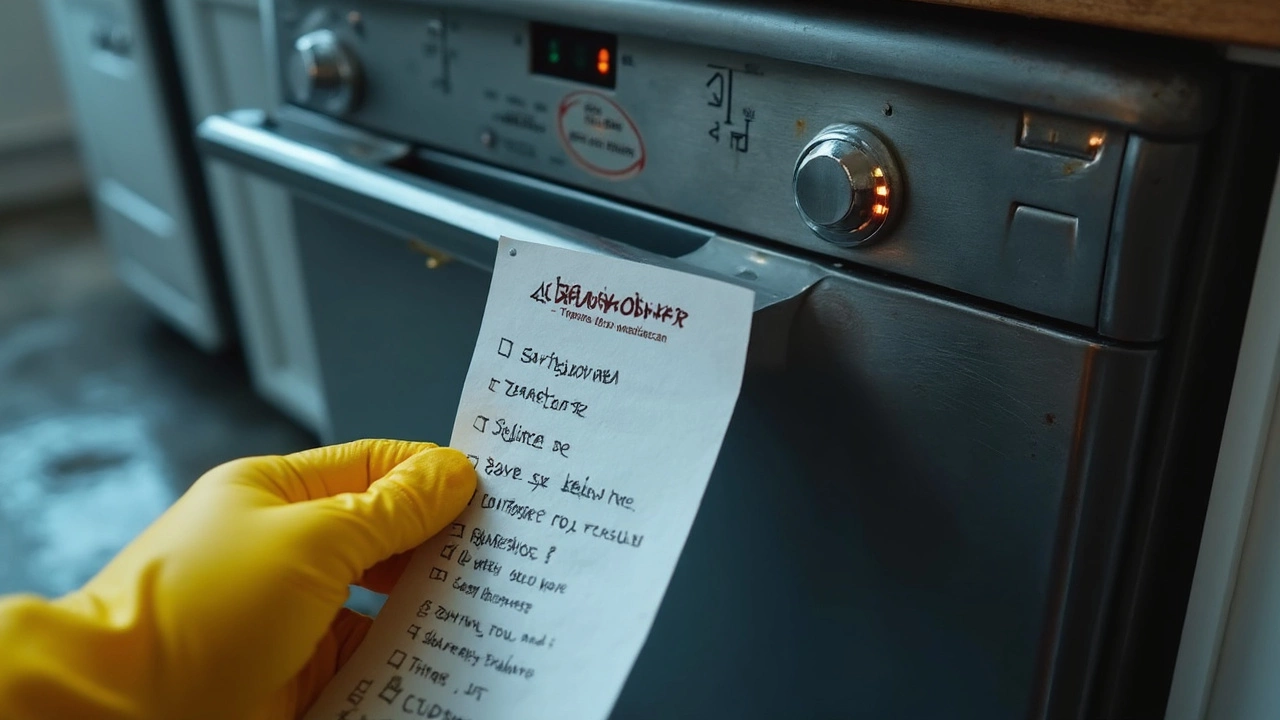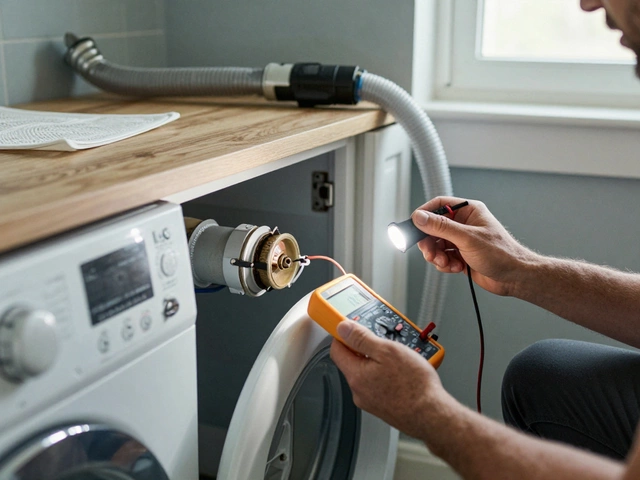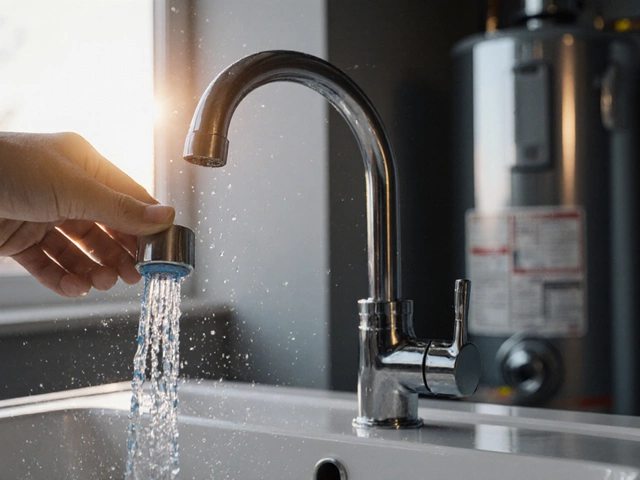Your dishwasher’s been acting up, but do you really need to toss it out and buy a new one? The answer’s hardly ever just black or white. Sometimes, that weird noise or leftover gunk is an easy fix. Other times, your machine is waving a white flag and begging for retirement.
First things first—look out for obvious signs like leaking water, strange grinding sounds, or dishes coming out just as dirty as they went in. These aren’t normal and usually mean something’s off inside your dishwasher. But don’t panic. Some issues, believe it or not, are way less dramatic than they look (or sound).
Knowing when to repair or replace is all about instinct, a few quick checks, and a dash of kitchen common sense. If you can spot early warning signs and know a couple of basic fixes, you could save hundreds of dollars—not to mention the headache of making the wrong call. Ready to figure it out together? Let’s walk through what you should actually watch for before you empty your wallet—or your kitchen.
- Spotting the Signs of Trouble
- Quick Fixes vs. Major Issues
- Is Your Dishwasher Too Old?
- Energy Bills and Water Waste
- Repair Costs Versus Replacement
- When to Call in a Pro
Spotting the Signs of Trouble
Dishwashers don’t just quit out of nowhere—they drop tons of hints as they start to fail. Spotting these early can spare you a flooded kitchen or a surprise cold rinse.
The big tip-offs are usually pretty obvious if you know what to look for:
- Leaking Water: If you find puddles around your dishwasher after a cycle, something’s not sealed right or a hose might be cracked.
- Strange Noises: Loud grinding, thuds, or squeals are bad news. A healthy dishwasher should sound like a gentle hum, not a garbage disposal going wild.
- Dirty Dishes: Plates and glasses with food stuck on after a wash? Could be clogged spray arms, a faulty pump, or a worn-out filter.
- Bad Smells: Musty, sour, or just plain awful smells point to trapped food, a failing drain, or sometimes an electrical problem.
- Door Won’t Latch: A latch that won’t click or stay shut means the cycle won’t even start, and it may be a simple fix or a sign the door’s bent or the sensor is shot.
- Long, Never-Ending Cycles: If it takes ages to finish, you might have a faulty thermostat or heating element.
It helps to know what’s normal, too. Most newer models run longer than the old ones, but a big jump in time or water usage can mean something’s broken. To back that up, check out this quick data table of typical dishwasher lifespans and common issues by year:
| Dishwasher Age | Common Problems | Repair or Replace? |
|---|---|---|
| 0-5 years | Clogs, minor leaks, water not heating | Usually repair |
| 6-10 years | Noisy runs, drain problems, spray arms fail | Start considering replacement |
| 11+ years | Frequent leaks, electronic failures | Replacement likely smarter |
If your machine is showing one or more of these signs, don’t ignore them. Ignoring leaks or electrical glitches can snowball into pricey damage elsewhere in your kitchen, fast.
The big takeaway? Once you start noticing something off with your dishwasher repair should be on your radar. Fixing small stuff early beats dealing with endless breakdowns or cleaning up water everywhere.
Quick Fixes vs. Major Issues
Let's face it—nobody wants to shell out for a new dishwasher if a quick tweak will do the trick. Some problems practically scream for DIY action, while others are like flashing red lights that say, “Call in the experts!” Knowing the difference is where you can save a bunch of money and avoid frustration.
Most everyday problems—like cloudy glasses, a weird smell, or a dishwasher that won’t start—have easy fixes. Here’s a rundown of what you can usually handle on your own:
- Dishwasher repair often starts with cleaning the filter, which can get clogged with food debris and block water flow.
- Spray arms can get jammed up with tiny bits of food—take them out and rinse them under the tap.
- If your dishwasher won’t start, check the power: is it plugged in? Did the breaker trip?
- Door not latching? Food or grime around the seal is a typical culprit. Wipe the rubber gasket with a damp cloth.
Now, for issues that usually mean a bigger problem (and possibly a bigger bill):
- Water leaking from underneath the machine
- Loud, grinding, or banging noises that don’t quit
- Burning smells or signs of melting plastic
- Pools of standing water at the bottom, even after a cycle
- Repeated error codes showing on digital displays
If you’re staring at any of those, it’s time to pause before grabbing your toolkit. Problems like a busted pump, broken heating element, or fried control board are signs the machine may either need a pro or—depending on the cost—retiring for good.
To put repair costs into perspective, check this data from a 2024 home appliance repair study:
| Common Repair | Average Cost (USD) |
|---|---|
| Unclog drain/filter | $75–$120 |
| Replace spray arm | $50–$130 |
| Fix water inlet valve | $150–$300 |
| Replace pump/motor | $350–$600 |
| Control board replacement | $400–$650 |
If you’re clocking repairs near the higher end and your dishwasher’s not new, replacement might be the smarter play. Quick fixes should put your machine back in action without major cost or drama. But once repairs edge toward half the price of a new dishwasher (or you spot those bigger warning signs), it's usually a signal to invest in a replacement instead of another round of repairs.
Is Your Dishwasher Too Old?
This is probably the biggest question most of us have. Dishwashers don’t last forever, even if you baby them. Most models hold up for around 9 to 12 years. If yours is pushing ten, it’s on borrowed time. Age is a quick way to sense if you’re better off replacing the old workhorse—or sinking more cash into repairs.
A dishwasher near the end of its lifespan won’t just start breaking down more often. It’ll likely waste more water, suck up more electricity, and just do a worse job cleaning your dishes. Back in 2010, the National Association of Home Builders pegged the average useful life of a dishwasher at around 9 years. Newer ENERGY STAR models can slash your water use in half compared to older tanks. If that’s not reason enough to check your model age, your monthly bill might convince you.
Here’s how the average dishwasher lifespan stacks up compared to related appliances, so you know if your machine’s just old, or really getting up there:
| Appliance | Average Lifespan (years) |
|---|---|
| Dishwasher | 9-12 |
| Washing Machine | 10-13 |
| Refrigerator | 13-17 |
| Microwave | 7-10 |
Wondering about yours? Check the model label—usually inside the door or on the side of the machine. If you can’t find the year, snap a picture and look it up online. If your dishwasher is older than your smartphone by a few years, it’s time to consider moving on. Replacement might just save you repair headaches and a little cash on your utilities too.

Energy Bills and Water Waste
If your energy bills are creeping up for no good reason, your dishwasher might be the silent culprit. Older dishwashers, especially the ones made before 2010, use way more water and electricity than today’s energy-efficient models.
Let’s put some numbers on it. A standard dishwasher made before 1994 uses about 10 to 15 gallons of water per load. Newer ENERGY STAR models? They use as little as 3 gallons per load. That's a big difference if your family runs the machine almost every day.
| Dishwasher Type | Average Water Used Per Load | Estimated Yearly Energy Use (kWh) |
|---|---|---|
| Pre-1994 | 10–15 gallons | ~900 |
| 2000–2009 | 6–10 gallons | ~600 |
| ENERGY STAR (2024+) | 3–5 gallons | ~270 |
Running an old dishwasher equals big waste over time. Even if it works, you’re paying extra month after month—and wasting a lot of water, which doesn’t do anyone any favors (including your wallet).
Watch for these clues your machine is hiking up your costs:
- Bills suddenly spike with no big changes in kitchen habits
- Water still left in the bottom after cycles
- Heat-drying takes forever or seems less powerful
- The dishwasher runs much longer than the cycle should be
Sometimes, the problem’s as simple as a clogged spray arm or filter. But if your unit is seriously outdated, you’re probably overdue for a replacement. A dishwasher repair on an energy hog won’t magically make it run like the new models. New dishwashers can cut your water use by over half and slash electricity costs, making them a smart investment instead of a money pit.
Repair Costs Versus Replacement
This is the part where your wallet either breathes a sigh of relief or starts to sweat. Let’s talk real numbers. On average, calling a pro to fix a standard dishwasher runs between $150 to $400. If you’re dealing with a burnt-out pump or a control board that’s decided to nap, costs climb up fast—the control board alone can set you back about $300, sometimes more after labor.
Before you spend a dime, check your dishwasher’s age. Most machines last around 9 to 12 years. If yours is pushing 8 or older, even a $200 fix might be throwing good money after bad. A brand new, basic dishwasher usually starts around $400, and high-end versions can go north of $1,200. Installing a new one, if you can DIY or have a handy friend, won’t blow up your budget. But if you need a pro, add $100 to $250 more.
A good rule: If the repair bill is half or more of what a new dishwasher repair job would cost, consider swapping it out. Here are a few simple questions that can help you decide:
- Is this the first problem, or just the latest in a string of breakdowns?
- Are your energy bills creeping higher (old machines hog power and water)?
- Does the dishwasher have visible rust, cracks, or weird puddles around it?
- Are replacement parts hard to find or overpriced?
Don’t just chase the cheapest fix. Factor in hassle, parts, and time. And if your dishwasher’s been making you apologize for dirty forks when friends come over, maybe it’s time for a fresh start.
When to Call in a Pro
You’ve tried the basics—checked the filter, run vinegar cycles, maybe even peeked under the kick plate. Still, your dishwasher’s not doing its job? Sometimes you just have to wave the white flag and bring in someone who actually fixes these things for a living.
Here’s when you really shouldn’t DIY anymore:
- Dishwasher repair involves electrical or wiring issues. If your dishwasher keeps tripping the breaker or you see sparks, don’t mess with it—safety first.
- Water pools on the floor every time you run it. Persistent leaks often mean seals or hoses deep inside need attention, and opening the machine wrong could cause a flood.
- The motor sounds like it’s grinding rocks, or there’s a burning smell. Burnt-out motors and melting wiring are pro territory.
- Your dishwasher just won’t start, or the control panel is dead, even after you’ve double-checked power sources.
- There’s visible rust inside, on racks, or worse—under the machine. This could mean internal parts are corroded and need more than just a scrub.
To give you an idea, most techs say if your repair will cost over 50% of what a similar new dishwasher would set you back, you’re probably better off replacing. Here’s a quick look at average costs:
| Problem Type | Average Repair Cost (USD) |
|---|---|
| Leaking or Drain Issues | $150 - $350 |
| Motor or Pump Repairs | $300 - $600 |
| Control Panel/Electrical Fixes | $200 - $450 |
| Buying a New Dishwasher | $500 - $1200 |
If your model is seven years old or more and you’re facing one of the steeper repair bills above, it’s probably not worth fixing. The cost curve just doesn’t make sense once you add up parts, labor, and time without a working machine.
And here’s a tip: a lot of major brands offer free diagnosis with paid repairs, or they might roll the trip fee into the service if you go ahead. If you call a pro, have your model number ready and describe what’s happening as clearly as possible. You’ll save money and get your kitchen back in action faster.





